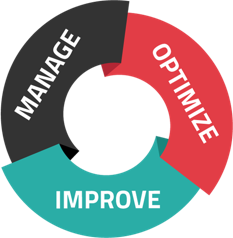
Small businesses face unique cybersecurity risks. If you want to stay ahead of the hackers, you need a risk management approach that's as flexible as it is intelligent--and we've got a few helpful tips to make that happen. Let's dive in!
Cybersecurity vs. Risk Management
First, let's take a closer look at what we're actually dealing with. Cybersecurity and risk management, while often used in the same sentences, can have slightly different meanings--and that matters a whole lot when every detail could make or break your defenses.
Here's a closer look:
Risk Management
Risk management isn't just about IT. In fact, you've likely heard the term in all kinds of business contexts--and that's because it's broad, generalized, and capable of being molded to fit the situation. Risk management helps you focus on anything that could create risk and find better, safer ways of doing the same things. That could mean improving a workflow, switching to a more reliable network provider, or training employees on smart communication practices. Through risk management, you strengthen both processes and the tools that enable them.
Cybersecurity
The most basic definition of cybersecurity is protection against digital dangers. That's often a combination of digital and physical efforts designed to protect your data, networks, and devices online. While it's more IT-focused than risk management, the ultimate goals are often the same; the only difference is that risk management can encompass processes and tools that aren't directly related to IT but may still have an impact.
Cybersecurity Risk Management
If you want the best of both worlds, you need to approach your digital defenses as "cybersecurity risk management." Managed IT services is a great example of bringing the approaches together.
What does that mean? Here are some examples:
- Look beyond IT tools themselves to understand the underlying processes that make them more or less secure.
- Understand how your position as a small business impacts cybersecurity risks.
- Approach cybersecurity from both human and technical standpoints.
- Think outside the box to identify cybersecurity risks that may not have obvious connections to your data or networks.
Top Tips for Cybersecurity Risk Management
Now that you know what cybersecurity risk management should look like, it's time to make it happen. Check out these tips for a smarter, stronger, safer business:
#1: Calculate Your Risk Levels
Part of cybersecurity risk management is understanding what your risks actually are. Here's a quick formula you can use:
Risk = Attack Likelihood x Attack Impact
Once you've calculated your risk levels (which often requires help from a security or IT audit), you'll have more visibility into what cybersecurity risk management should actually look like and how you can put it into practice.
#2: Think Inside The Box
When it comes to cybersecurity of any kind, there's always value in thinking outside the box. However, if you get too caught up in trying to think like a digital criminal, you may overlook some of the smaller, seemingly innocent ways your data could be in danger. That's why it's important to "think inside the box" sometimes, too.
For example, don't focus all your cybersecurity risk management efforts on external issues. In some cases, your own employees could be creating risks without realizing it--for example, leaving documents on a printer with easy public access. Luckily, in this case, risk management is as easy as training employees, implementing tools such as follow-me printing, and moving your printer to a more secure location.
#3: Don't Underestimate Monitoring
While it's tempting to invest time, money, and effort in active tools and solutions, cybersecurity risk management doesn't have to be a constant flurry of motion. Sometimes it's equally effective to know how to sit still and watch. That's where remote, 24/7 monitoring comes in--and yet another reason managed IT services is a great way to improve cybersecurity risk management. Your managed IT provider will do the monitoring work for you, flagging any suspicious activity so you can respond quickly and intelligently instead of panicking and making knee-jerk decisions.
#4: Be Efficient
Small businesses need to take a unique approach to cybersecurity risk management. It's especially important for you to invest in the smartest, most efficient solutions--those that check multiple boxes at once. In the same way that cybersecurity risk management itself is a combination of approaches, you need to put different processes together so you don't waste time or money gathering every new digital defense on the market.
Conclusion
Cybersecurity risk management is a unique challenge for small businesses, but it represents a lot of opportunity, too. All you have to do is remember that "cybersecurity" and "risk management" don't have to be two separate things--especially when you have expert help on your side.
Don't tackle cybersecurity risk management alone. Contact us today to let managed IT services protect your small business.



